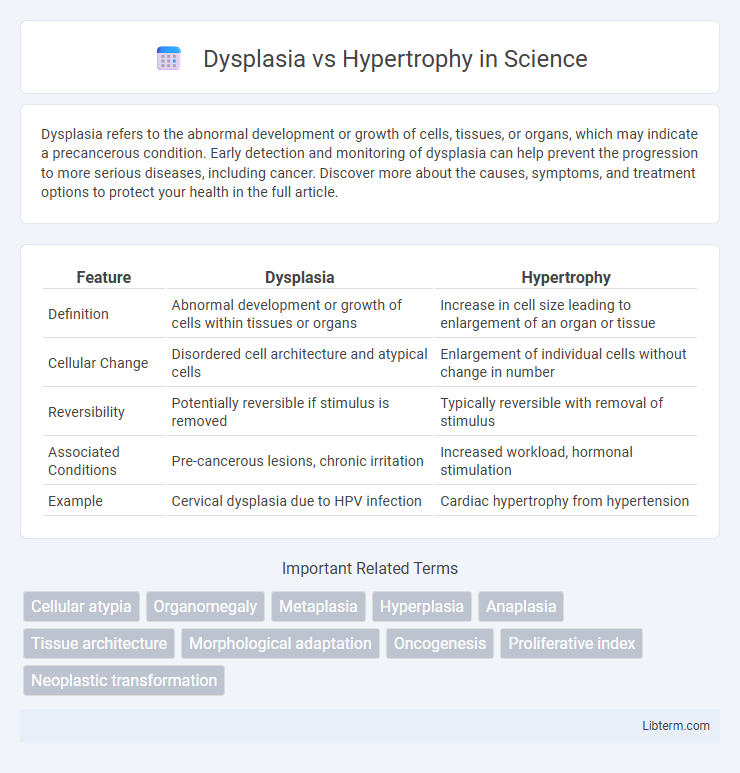Dysplasia refers to the abnormal development or growth of cells, tissues, or organs, which may indicate a precancerous condition. Early detection and monitoring of dysplasia can help prevent the progression to more serious diseases, including cancer. Discover more about the causes, symptoms, and treatment options to protect your health in the full article.
Table of Comparison
| Feature | Dysplasia | Hypertrophy |
|---|---|---|
| Definition | Abnormal development or growth of cells within tissues or organs | Increase in cell size leading to enlargement of an organ or tissue |
| Cellular Change | Disordered cell architecture and atypical cells | Enlargement of individual cells without change in number |
| Reversibility | Potentially reversible if stimulus is removed | Typically reversible with removal of stimulus |
| Associated Conditions | Pre-cancerous lesions, chronic irritation | Increased workload, hormonal stimulation |
| Example | Cervical dysplasia due to HPV infection | Cardiac hypertrophy from hypertension |
Understanding Dysplasia: Definition and Causes
Dysplasia refers to the abnormal development or growth of cells, tissues, or organs, often characterized by changes in size, shape, and organization of cells. It arises primarily from chronic irritation, inflammation, or genetic mutations that disrupt normal cell maturation and differentiation processes. Unlike hypertrophy, which involves an increase in cell size without altering cellular structure, dysplasia indicates a precancerous state and requires careful clinical evaluation for potential progression to malignancy.
Hypertrophy Explained: What It Means for Tissues
Hypertrophy refers to the increase in the size of cells, leading to the enlargement of tissues or organs without an increase in cell number, commonly seen in muscle tissues due to exercise or pathological conditions like hypertension. Unlike dysplasia, which involves abnormal cell development and arrangement, hypertrophy maintains normal cellular structure but amplifies functional capacity. This adaptive response can be physiological, as in skeletal muscle growth, or pathological, such as cardiac hypertrophy caused by chronic high blood pressure.
Key Differences Between Dysplasia and Hypertrophy
Dysplasia refers to the abnormal development or growth of cells, tissues, or organs, often indicating a precancerous state with disorganized cellular structure, while hypertrophy involves the increase in the size of existing cells leading to the enlargement of an organ or tissue without changes in cellular number. Dysplasia is characterized by cellular atypia and potential progression to malignancy, whereas hypertrophy primarily results from increased functional demand or hormonal stimulation without malignant transformation. The key difference lies in dysplasia's association with abnormal, potentially reversible cellular changes and hypertrophy's role as an adaptive, typically non-pathological enlargement.
Cellular Changes: Dysplasia vs Hypertrophy
Dysplasia involves abnormal cellular growth characterized by variations in cell size, shape, and organization, often preceding cancer development. Hypertrophy refers to the increase in the size of individual cells, leading to tissue enlargement without altering the number of cells. Cellular changes in dysplasia include disordered architecture and nuclear atypia, whereas hypertrophy manifests as enhanced cellular components to support increased functional demand.
Common Sites Affected by Dysplasia and Hypertrophy
Dysplasia commonly affects epithelial tissues in areas such as the cervix, respiratory tract, and gastrointestinal lining, where abnormal cellular changes can lead to precancerous conditions. Hypertrophy primarily occurs in muscular organs like the heart and skeletal muscles, resulting from increased cell size due to heightened workload or stress. Understanding the distinct sites involved aids in diagnosing and treating underlying pathological processes specific to each condition.
Clinical Implications and Risk Factors
Dysplasia involves abnormal cellular growth and differentiation, often serving as a precursor to cancer, particularly in tissues like the cervix or respiratory tract, necessitating regular screening and early intervention. Hypertrophy refers to the enlargement of cells leading to increased organ or tissue size, commonly seen in conditions such as left ventricular hypertrophy due to hypertension, which increases the risk of heart failure. Understanding these distinct pathological processes aids clinicians in tailoring risk assessment, monitoring strategies, and therapeutic approaches to prevent progression to malignancy or organ dysfunction.
Diagnostic Approaches: Identifying Dysplasia and Hypertrophy
Diagnostic approaches for dysplasia involve histopathological examination using biopsy samples to detect abnormal cellular growth and architectural disorganization, often employing immunohistochemical staining to identify specific biomarkers. Hypertrophy diagnosis relies on imaging techniques such as ultrasound or MRI to measure organ or tissue enlargement, alongside clinical evaluation of functional changes and laboratory tests assessing related biochemical markers. Accurate identification of dysplasia and hypertrophy is critical for guiding treatment strategies, often requiring a combination of morphological assessment and molecular diagnostics.
Treatment Strategies: Managing Each Condition
Treatment strategies for dysplasia focus on early detection and removal of abnormal cells through procedures like biopsy, laser therapy, or surgical excision to prevent progression to cancer. Managing hypertrophy involves addressing the underlying cause, such as reducing mechanical stress through physical therapy, medications like anti-inflammatory drugs, or surgical intervention if the tissue overgrowth impairs function. Tailoring treatment to the specific pathology of cellular abnormality in dysplasia versus tissue enlargement in hypertrophy is essential for effective management and improved patient outcomes.
Prognosis and Long-Term Outcomes
Dysplasia often indicates abnormal cellular growth with a potential to progress to malignancy, requiring close monitoring and sometimes intervention to prevent cancer. Hypertrophy, characterized by the enlargement of cells without atypical changes, typically results from increased functional demand and generally has a more favorable prognosis with reversible outcomes if the underlying cause is addressed. Long-term outcomes of dysplasia depend on the grade and site, with high-grade dysplasia posing a significant risk of malignant transformation, whereas hypertrophy rarely leads to neoplastic progression.
Preventive Measures and Future Research Directions
Preventive measures for dysplasia emphasize early detection through regular screenings, lifestyle modifications to reduce carcinogen exposure, and vaccination against oncogenic viruses like HPV. In contrast, hypertrophy prevention centers on managing underlying causes such as hypertension and hormonal imbalances through medication, diet, and exercise. Future research aims to develop molecular biomarkers for precise diagnosis, non-invasive imaging techniques for real-time monitoring, and targeted therapies that can reverse pathological changes in both dysplasia and hypertrophy.
Dysplasia Infographic

 libterm.com
libterm.com